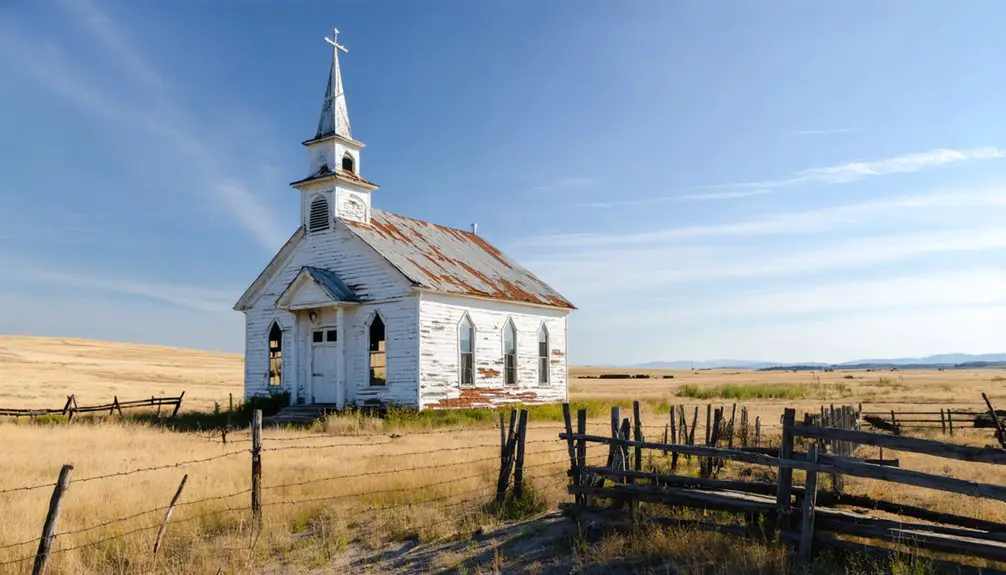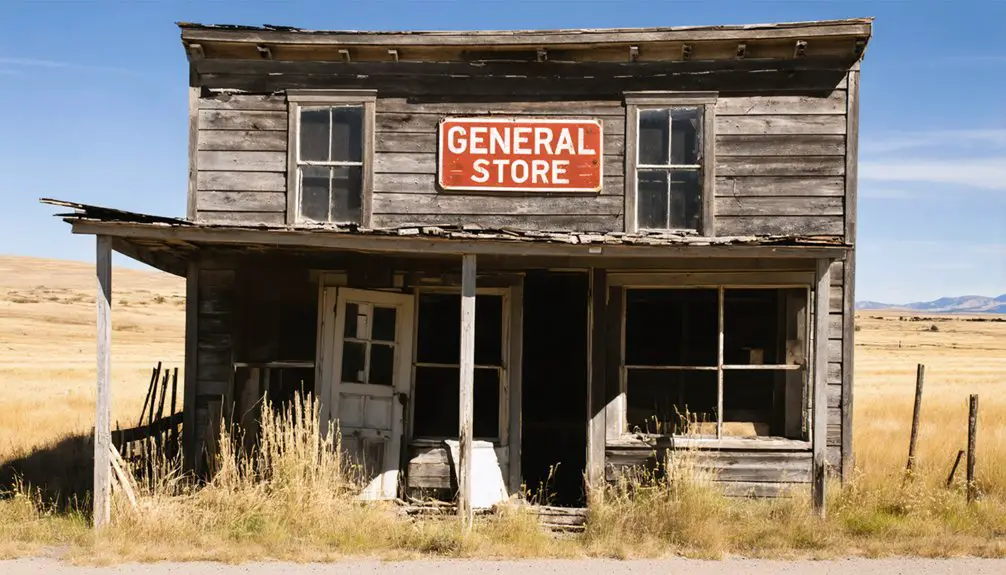You’ll find Dooley, Montana’s remains along the former Soo Line Railroad, where this once-bustling agricultural hub sprang to life in 1912. The town rapidly grew to 40 buildings, including two general stores, a bank, and multiple grain elevators. Natural disasters, including devastating fires (1916-1920) and a 1934 tornado, combined with agricultural depression and harsh Montana conditions, led to its decline. Today, only two grain elevators and scattered remnants reveal Dooley’s dramatic story.
Key Takeaways
- Founded in 1912 along the Soo Line Railroad, Dooley was once a thriving agricultural hub with 40 buildings in its business district.
- Multiple devastating fires between 1916-1920, harsh weather, and agricultural challenges led to the town’s gradual decline.
- Natural disasters, including a 1934 tornado and recurring pest infestations, severely impacted the community’s farming-based economy.
- The Great Depression of the 1930s accelerated population loss, transforming Dooley from a bustling town into a ghost town.
- Today, only two grain elevators remain operational, with a commemorative boulder placed in 2005 marking the town’s historical significance.
The Birth of a Railroad Town
When the Soo Line Railroad reached W.D. Dooley’s homestead in 1912, it sparked the creation of one of Montana’s most promising frontier towns.
You’ll find that Dooley’s emergence was distinctly tied to railroad influence, as the Soo Line strategically platted the town on the northeast corner of Dooley’s property, establishing one of their first four depots along the Whitehall branch line. C.E. Tessier served as the town’s first depot agent in 1913.
Unlike neighboring settlements, Dooley didn’t need to relocate after the railroad’s arrival. W.D. Dooley, whose Irish surname marked him as a noble warrior, established deep roots in the area.
The railroad’s presence triggered rapid community growth, with approximately 40 buildings quickly forming a bustling business district.
The town became a crucial agricultural hub, featuring multiple grain elevators that handled substantial wheat shipments, including exports from across the Canadian border.
Daily Life in Early Dooley
As Dooley flourished in its early years, you’d find a vibrant community life centered around its bustling business district of forty buildings. You could shop at two general stores, bank at Citizens State Bank, or gather at Wright’s hardware store before the theater was built.
After sunset, you’d have electricity until midnight thanks to Loyal Goss’s power plant, though Tuesdays offered limited daytime power.
Community gatherings defined the town’s spirit, from home talent plays to Fourth of July celebrations with bucking broncs and foot races. The town’s sports culture thrived around its renowned baseball team, while the local band and Commercial Club kept civic engagement strong. Like many communities along the Soo Line Corridor, Dooley developed around the railroad tracks with high hopes for prosperity.
For daily needs, you’d find two doctors, barbers, four lumber yards, and blacksmiths ready to repair your farm equipment.
Natural Disasters and Setbacks
Dooley’s promising trajectory took a devastating turn through a series of catastrophic fires between 1916 and 1920.
These blazes ravaged both sides of Main Street, destroying crucial businesses and accelerating the town’s decline. Natural disasters and economic setbacks continued to plague the community, delivering crushing blows to its survival. Like many abandoned communities across Montana, Dooley fell victim to circumstances beyond its control.
You’ll find these devastating events shaped Dooley’s fate:
- The brutal winter of 1915-16 paralyzed the Soo Line trains, cutting off essential supplies.
- A destructive 1934 tornado demolished the Stadig Livery Barn.
- Recurring infestations of armyworms, grasshoppers, and Mormon crickets devastated local crops.
- Multiple fires within a four-year span crippled business districts beyond recovery.
These relentless calamities ultimately transformed Dooley from a bustling railway stop into an abandoned ghost town. The town’s forty buildings constructed during its early days in 1913 now stand as silent remnants of its brief prosperity.
Agricultural Struggles and Economic Hardships
You’ll find that Dooley’s early homesteaders faced devastating agricultural setbacks from the harsh Montana climate, which routinely destroyed their crops through severe winters and droughts.
The region’s poor soil quality and challenging growing conditions crushed settlers’ farming dreams, making sustainable agriculture nearly impossible.
Adding to their misfortunes, waves of destructive insects including armyworms, grasshoppers, and Mormon crickets decimated what little the farmers managed to grow.
Harsh Weather Ruins Crops
When devastating winter storms buried the Soo Line railroad under 17-foot snowdrifts in 1915-16, Dooley’s farming community faced its most challenging season yet.
With limited crop resilience against Montana’s harsh climate, you’d find farmers struggling to maintain their livelihoods as weather adaptations proved futile.
The brutal weather conditions created four major challenges:
- Weeks-long train disruptions left residents without essential fuel supplies
- Frozen fields delayed important spring planting schedules
- Deep snow prevented regular grain shipments to market
- Extended cold snaps threatened both livestock and winter wheat survival
As harsh winters repeatedly battered the region, Dooley’s agricultural dreams began to crumble.
The combination of transportation failures and crop damage dealt devastating blows to the town’s farming economy, pushing many families toward financial ruin.
Failed Homesteading Dreams
Despite early promises of agricultural prosperity, the harsh reality of homesteading near Dooley became evident by the 1920s as settlers discovered land unsuitable for intensive farming.
Poor soil conditions and environmental challenges crushed community aspirations, forcing many to abandon their homesteading dreams.
The agricultural depression of the 1920s dealt the first major blow, with falling crop prices and low yields making farming unprofitable.
When the Great Depression hit in the 1930s, it intensified these homesteading challenges.
You’d have witnessed farmers losing their land while others simply walked away.
The town’s essential infrastructure crumbled as grain elevators were sold off and businesses shuttered.
What began as an optimistic farming settlement transformed into a cautionary tale, with Dooley’s remaining structures standing as silent reminders of broken dreams and failed agricultural ambitions.
Insect Plagues Strike Farms
As if homesteaders near Dooley didn’t face enough challenges, devastating locust plagues struck their farms with merciless intensity.
You’d witness massive locust swarms stretching over 1,000 miles, darkening the skies above Montana’s prairies. Settlers watched helplessly as gray-green screens of insects blocked out the sun. The crop devastation was complete and merciless, leaving nothing behind for survival. The plagues caused an estimated over $200 million in crop damage across affected regions.
Here’s what you’d face during these brutal infestations:
- Total destruction of every edible crop, with locusts devouring everything from wheat to vegetables.
- Contaminated water sources from masses of dead insects, causing livestock to refuse drinking.
- Inedible poultry after birds consumed locusts, their meat tainted with reddish-brown oil.
- Damaged farm equipment and property, with locusts even stripping wool from sheep.
Your conventional defense methods proved futile against these overwhelming swarms, which could smother fires and defeat mechanical controls like the hopperdozer.
The Path to Abandonment
Though Dooley initially flourished as a promising Soo Line Railroad stop in the 1910s, a series of devastating setbacks sealed its fate.
Despite showing remarkable community resilience through multiple fires and natural disasters, the town’s foundations began crumbling by the 1920s. You’d have witnessed a steady population migration as agricultural challenges mounted and the Great Depression struck.
The final decline accelerated through the 1930s and ’40s, marked by the destructive 1934 tornado that leveled the Stadig Livery Barn.
As farming became increasingly unsustainable, grain elevators were sold off and buildings were abandoned or demolished.
Historic Landmarks and Preservation Efforts

While Dooley’s physical presence has largely vanished from Montana’s landscape, the Rocky Valley Lutheran Church stood as its most significant historic landmark until 2019.
When structural failure claimed this National Register-listed building, it highlighted the severe preservation challenges facing remote ghost towns.
Like many towns that developed along the Soo Line spur, Dooley became a testament to early 20th century railroad expansion.
Today, you’ll find these remaining traces of Dooley’s past:
- Two operational grain elevators, privately owned and maintained
- A commemorative boulder placed in 2005, though its etched images are weathering away
- Occasional documentation in regional historical blogs and societies
- Local community storytelling that keeps the town’s memory alive
Despite limited resources and harsh climate conditions, community involvement continues through grassroots preservation efforts.
Though without major governmental support, Dooley’s physical heritage faces an uncertain future.
Frequently Asked Questions
What Native American Tribes Originally Inhabited the Dooley Area?
You’ll find that Native tribes including the Salish, Kootenai, and Pend d’Oreilles primarily inhabited Dooley’s region, sharing this cultural heritage before European settlement, with Blackfeet influence from the east.
Are There Any Remaining Descendants of Dooley’s Original Settlers Still Nearby?
While descendant stories remain largely undocumented, you’ll find ghost town connections through privately owned grain elevators. There’s evidence that at least one family stayed during the decline, but no confirmed lineages persist.
What Happened to the Town’s Cemetery and Burial Records?
You’ll find limited cemetery restoration efforts, with about 160 burial records now preserved on Find A Grave. Original documentation has scattered due to town abandonment, leaving most physical records fragmented or lost.
Can Visitors Legally Explore the Dooley Ghost Town Site Today?
Like a ship without a compass, you’re charting uncertain waters. While public roads lead to the site, there aren’t clear exploration regulations. You’d need to verify ghost town accessibility with Sheridan County officials.
Were There Any Notable Crimes or Lawlessness During Dooley’s Peak Years?
You won’t find records of significant crime history or major law enforcement issues during Dooley’s peak. Beyond minor fuel thefts and property damage from fires, there’s no evidence of notable criminal activity.
References
- https://en.wikipedia.org/wiki/Dooley
- https://kids.kiddle.co/Dooley
- http://sites.rootsweb.com/~mtscdgs/dooley.html
- https://montanahistoriclandscape.com/2013/06/07/soo-line-towns-in-sheridan-and-daniels-counties/
- https://www.mtmemory.org/nodes/view/128859
- https://fotospot.com/attractions/montana/dooley-ghost-town
- https://montanahistoriclandscape.com/tag/soo-line/
- https://kids.kiddle.co/List_of_ghost_towns_in_Montana
- https://www.distinctlymontana.com/lost-montana
- https://montanahistoriclandscape.com/tag/sheridan-county/



